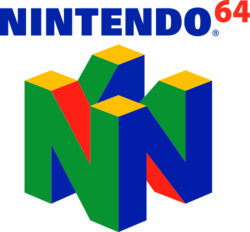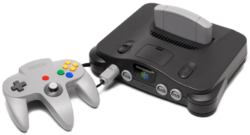| Site Notice |
|---|
|
We have a limited coverage policy. Please check our coverage page to see which articles are allowed. |
Difference between revisions of "Nintendo 64"
Kagegamer12 (talk | contribs) (I'll probably add more things later for the N64) |
|||
| Line 1: | Line 1: | ||
| + | {{Console infobox | ||
| + | | name = Nintendo 64 | ||
| + | | jpkana = ニンテンドー64 | ||
| + | | jpname = Nintendō Rokujūyon, NINTENDO64 | ||
| + | | logo = [[file:Nintendo_64_Logo.png|250px]] | ||
| + | | picture = [[file:N64-console.png|250px]] | ||
| + | | generation = [[5th Generation]] | ||
| + | | predecessor = [[Super Nintendo Entertainment System]] | ||
| + | | successor = [[Nintendo GameCube]] | ||
| + | | games = [[List of Nintendo 64|387]] (as of August 14, 2007) | ||
| + | | best_games = ''[[Super Mario 64]]'' (11 million copies as of May 21, 2003) | ||
| + | | last = ''[[Tony Hawk's Pro Skater 3]]'' (August 20, 2002) | ||
| + | | media = [[Nintendo 64 ROM Cartridge]] | ||
| + | | memory = Cartridge battery, [[Nintendo 64 Controller Pak]] (256 kbit/32 kB) | ||
| + | | cpu = 93.75 MHz NEC VR4300 | ||
| + | | connects = [[Game Boy]] and [[Game Boy Color]] | ||
| + | | input = [[Nintendo 64 Controller]], [[Jumper Pak]], [[Expansion Pak]], [[Rumble Pak]], [[Transfer Pak]], [[Nintendo 64DD]], [[VRU]]. ''[[List of Nintendo 64 Accessories|(more)]]'' | ||
| + | | backwards = none | ||
| + | | forwards = none | ||
| + | | launch = <br /> | ||
| + | *NA - September 29, 1996 | ||
| + | *JP - June 23, 1996 | ||
| + | *EU - March 1, 1997 | ||
| + | *AUS - March 1, 1997 | ||
| + | | span = 6 years | ||
| + | | discontinue = 2002 | ||
| + | | sold = <br /> | ||
| + | *Worldwide - 32.93 million | ||
| + | *NA - 20.63 million | ||
| + | *JP - 5.54 million | ||
| + | *EU/AUS - 6.75 million | ||
| + | }} | ||
| + | |||
| + | |||
The '''Nintendo 64''' (ニンテンドー64, ''Nintendō Rokujūyon'', NINTENDO64) was a video game console created by [[Nintendo]]. It was released in 1996 to compete with the [[wikipedia:Sega Saturn|Sega Saturn]] and [[wikipedia:PlayStation|PlayStation]]. | The '''Nintendo 64''' (ニンテンドー64, ''Nintendō Rokujūyon'', NINTENDO64) was a video game console created by [[Nintendo]]. It was released in 1996 to compete with the [[wikipedia:Sega Saturn|Sega Saturn]] and [[wikipedia:PlayStation|PlayStation]]. | ||
Revision as of 04:55, 3 May 2011
| Nintendo 64 ニンテンドー64 Nintendō Rokujūyon, NINTENDO64 | ||||||||||
| ||||||||||
| ||||||||||
| ||||||||||
| ||||||||||
| ||||||||||
|
The Nintendo 64 (ニンテンドー64, Nintendō Rokujūyon, NINTENDO64) was a video game console created by Nintendo. It was released in 1996 to compete with the Sega Saturn and PlayStation.
The Nintendo 64 was very popular for many reasons, one of the big ones being the release of Super Mario 64. Super Mario 64 was one of the first games of its kind to feature full 3D graphics and depth of field effects. The Nintendo 64 was able to pull this off because it was the first system to feature a 64-Bit processor and 32-bit graphics chip (aside from the failed Atari Jaguar, which was really 32-bit) The Nintendo 64 also featured the first successful analog control sticks, and four built-in controller ports. The Nintendo 64 was also noted as the last home console system to use cartridges, before Nintendo started using discs like it's competitors.
The Nintendo 64 hosted a wide variety of games, but most of its hits were first-party titles such as Super Mario 64, Super Smash Bros., Mario Kart 64, Mario Party, Star Fox 64, Legend of Zelda: Ocarina of Time and F-Zero X. Rareware, however, developed quite a few hits for the N64, such as Goldeneye 007, Banjo-Kazooie and Donkey Kong 64. Production ended in 2002, the last game released for it being Tony Hawk's Pro Skater 3
References
The Nintendo 64 has made a few appearances in Mario games as an easter egg. A Nintendo 64 appears in Super Smash Bros. Melee in the background of the stand where all of the player's trophies are. Francis, from Super Paper Mario also owns a Nintendo 64 as well as a Nintendo GameCube, Virtual Boy and Wii. In Super Smash Bros. Brawl, one of the names that can appear whenever a player presses the random button when they're naming their custom stage is N64, which is a reference to the old system.
See Also
| This article is a stub. You can help NintendoWiki by expanding it. |
| |||||||||||||||||||||
| |||||||||||||||||||||
| |||||||||||||||||||||



